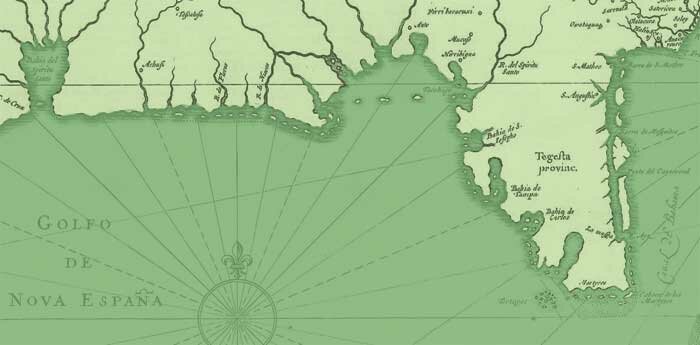Florida was discovered by Ponce de Leon on Easter Sunday 1513 For the next decade he searched for the elusive Fountain of Youth while fighting off malaria, yellow fever and Calusa Indians. The land he christened "Pascua de Florida" (feast of flowers) would be his death. In 1521 de Leon and his men met their match when the ran across the Calusa chief known as San Carlos on Ostero Island near present day Ft. Myers. Depending on who you ask, he was either buried there, or was returned to Cuba or Spain Regardless of where his body was buried, his quest for the fountain of youth was for naught.
Compared to the rest of the Spanish Main Florida was no great treasure trove. However, due to its location it was strategically important. Spain used Florida as a staging area for her convoys. Groups of heavily-laden Spanish vessels, called the plate fleets, usually sailed up the Gulf Stream through the straits that parallel Florida’s Keys. Aware of this route, pirates preyed on the fleets. Hurricanes created additional hazards, sometimes wrecking the ships on the reefs and shoals along Florida’s shores.

With the English Colonies just North in Charles Town, Carolina (Present Day Charleston South Carolina), it became obvious to Spain that their Florida Possession needed to be fortified. In 1564, the English invaded Florida along St. Johns River. This proved to be a major danger to Spain's treasure fleets. As a result of this incursion into Florida, King Phillip II named Don Pedro Menendez de Aviles, Spain's most experienced admiral, as governor of Florida Menendez ordered to explore and colonize Florida and drive out any pirates or settlers from other nations, should they be found there.
Menendez arrived off the coast of Florida on August 28, 1565, the Feast Day of St. Augustine. Eleven days later, he and his 600 soldiers and settlers came ashore at the site of the Timucuan Indian village of Seloy with banners flying and trumpets sounding. He hastily fortified the fledgling village and named it St. Augustine. It was from here that Spain would establish is most Northern post on the Spanish Main and try to wipe out the scourge of piracy.
Menendez had his work cut out for him. Cutthroats, bandits , runaway slaves, disgruntled merchantmen and disinherited youth flocked to the Tortugas, Point Royal and other known recruiting centers for piracy and privateering in the search for plunder. The easy plunder was the ships and towns of the Spanish Main.
As with most shipwrecks, Spain attempted to salvage what it could and pirates would use the opportunity for easy pickings. Pirates were probably Florida's first beach combers; patrolling the coast after storms looking to see what or who washed ashore. Spanish sailors or well to do passengers who managed to survive a ship wrecked during a storm could very well find themselves in the hands of pirates and being sold into slavery or ransomed for reward. Or perhaps they would be tortured in an effort to discover where the ship sank. Ships sunk in shallower water would be quickly visited by patrolling pirates. Survivors were only worth picking up, if they could offer some kind of prize. Even then they were left to the mercy of the pirates.
Piracy did not end with the Spaniards. As late as 1823 The US Government dispatched Commodore David Porter to the Keys to rid the coastline of pirates like Black Caesar and Jean LaFitte. Today, Florida is rich in the history of piracy and shipwrecks but the threat form piracy has practically disappeared. While pirates and smugglers still try to make the waters around Florida their home, they are no match for the diligence of the U.S. Coast Guard.

The only author and editor of all pages on the site. Most of what I write about is based on years of book reading on the topic. My first web page was published back in 1994.